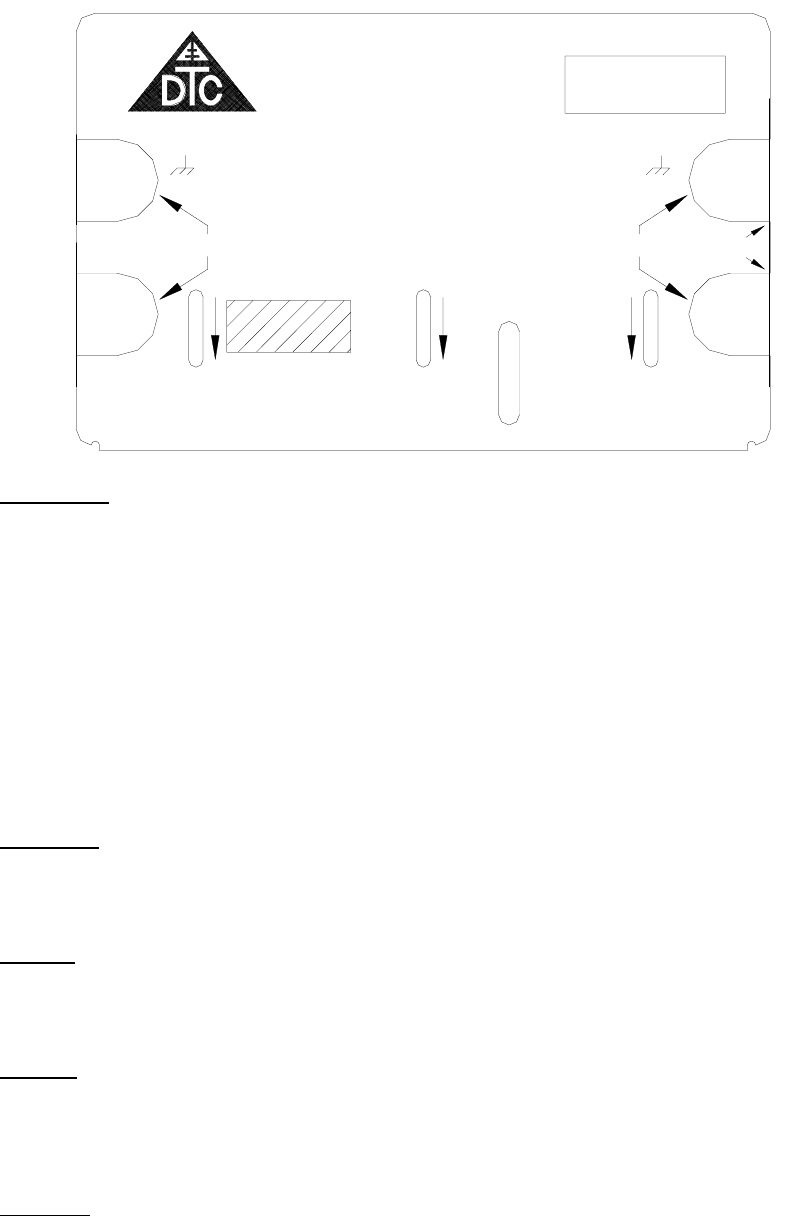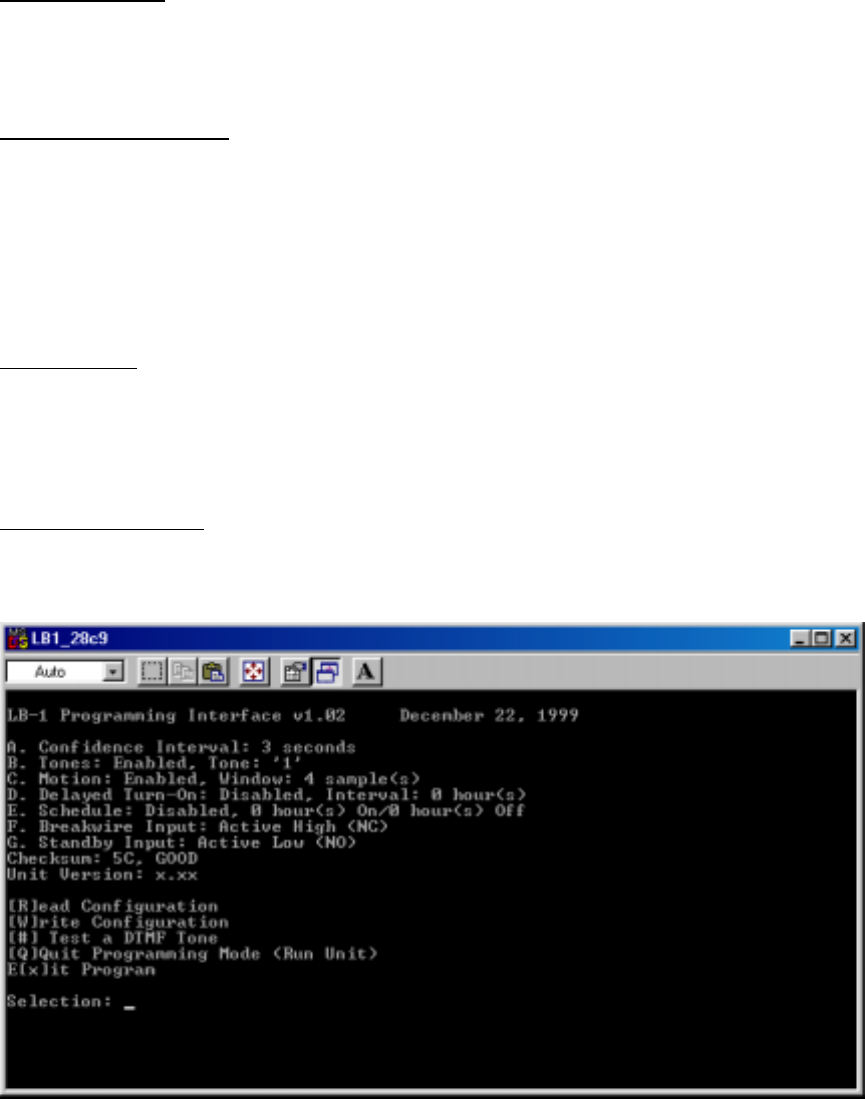DTC Communications LB1 Law Enforcement Tracking Transmitter User Manual LB 1 Operators Manual
DTC Communications Inc. Law Enforcement Tracking Transmitter LB 1 Operators Manual
Manual

DTC Communications, Inc. Page 1 of 7
LB-1 Beacon Operators Manual
Version 1.0
DTC Communications, Inc.
May 2001

DTC Communications, Inc. Page 2 of 7
FCC RF EXPOSURE STATEMENT
When installed as directed, this equipment complies with the FCC radiation exposure limits as set forth for
both uncontrolled and controlled environments. This equipment produces a finite-time, low- power, low-
duty cycle signal that is under the limits for specific absorption rate in any deployment scenario.
FCC TYPE CERTIFICATION
This equipment complies with the FCC Part-90 requirements and has been type certified.
FCC ID: H25LB1
Introduction
The LB-1 Letter Beacon is a micropower, credit card sized transmitter that operates in the VHF band (150-
174 MHz). It is used for event monitoring and package tracking purposes by law enforcement agencies.
The beacon emits short-duration, low-power radio signals. The LB-1 reports status, event and motion
information as well as battery condition with low-duty cycle transmissions, thus greatly increasing the
unit’s battery life. The reporting tone codes may be customized by the user using a software package. The
LB-1 is also capable of transmitting unmodulated tracking pulses for pseudo-doppler type tracking
receivers such as the DTC TRAK/R-2000.
The device may also be programmed to begin or cease transmissions on a schedule based on a real-time
clock. Both the batteries and the antenna are internal to the unit.
The LB-1 is a self-contained beacon featuring:
• DTMF tone generation
• Multi-tone generation
• Tracking Pulse capability
• Breakwire capability
• Standby capability
• User programmability
• Delayed operation mode
• Scheduled operation mode
• Reliable battery contacts with no battery compartment door to lose
• Unique “tape-down” contacts for fine wires (Breakwire and Standby)
• Operator interface through an on-board button and LED
• Special status tones transmitted to indicate low battery and motion
• On-board motion detection
• Integrated, optimized antenna

DTC Communications, Inc. Page 3 of 7
BREAKWIRE STANDBY RESET
STATUS
REMOVAL
BATTERY
LB-1 HOLD RESET BUTTON
FOR 5 SECONDS FOR
DEFAULT OPERATION
A
M
P
R
G
R
O
Architecture
The control architecture of the LB-1 consists of three major blocks: the main microprocessor, the audio
generator, and the transmitter.
The main microprocessor is an ultra-low current device, running at 32 KHz. It performs all the timing and
monitoring functions, and communicates with the user via a serial port. The processor uses less than 100
uA of current, which insures a long battery life.
The audio generator is another microprocessor that functions as an audio tone generator. It runs at high
speed, which requires more battery power. Thus, it is only powered up when tone generation is required.
The transmitter is a stable, crystal-controlled transmitter with a power output of 30 mW, typical, (50 mW
maximum) over the rated battery life.
Dimensions
The LB-1 is nominally 3.37 in. x 2.125 in. x 0.120 in.
Labeling
The label on the bottom of the PC Board labels all significant functions and contacts. The label is designed
to be visually low-key.
Batteries
The only battery that should be inserted into the LB-1 is the CR-2016. The battery will only function when
the negative contact (the button) is toward the label. Inserting the batteries upside down will not harm the
unit, but it will not function properly.
CAUTION: When inserting batteries, be certain that the battery is going between the gold plated contacts
in the slot, and NOT between a contact and the plastic sidewall of the battery compartments. This could
damage the contacts beyond function.

DTC Communications, Inc. Page 4 of 7
The battery life is a direct function of how often the transmitter is operated. Typically, the beacon will be
in the confidence tone mode most of the time. The less frequent the confidence tone, the longer the
batteries will last. The most frequent confidence tone possible is every three seconds. In the three-second
mode, the battery life will exceed 36 hours, with enough life remaining to transmit an alarm for 15 minutes.
After 15 minutes, the alarm mode will be cancelled to conserve battery life and it will revert to transmitting
confidence tones. This will help recover the unit should it not be recovered in the allotted time.
The following table is an engineering estimate of battery life for different confidence tone intervals. It
represents the maximum period of time available in confidence tone mode, followed by a 15-minute alarm
interval.
Confidence interval (sec.) 4 6 9 10 15 30 60
Battery life before alarm (Hours) 43.5 87 130.5 145 217.5 435 870
Battery removal is accomplished by pushing the batteries out of the housing through the three slots that
have been provided for this purpose. Ideal tools for this purpose include a fine point pen, a paper clip, or a
penknife.
Unique, tape-on wire attachments
In the past, previous beacon transmitters have used screw-terminal type contacts for the attachment of fine
(#40) wire. This wire was also insulated with an enamel coating, and required “stripping” in the field. A
great number of reliability problems resulted from this method of attaching the Breakwire and Standby
wires. The LB-1 takes a completely different approach.
First, the use of insulated wire was abandoned. Eliminating the need to strip the fine wire in the field
greatly improves reliability, since the problem of nicking the wire or weakening it with heat is eliminated.
Of course, the wire should not loop back upon itself, nor be wrapped around a conductive surface, since it
is not insulated.
Secondly, the problem of weakening the wire by pinching it by a screw is eliminated by the use of a unique
tape-down attachment method. Inspired by the taped-down electrodes used in the medical industry, the
uninsulated fine wire is taped down over gold-plated contacts on the back of the LB-1. Ordinary tape, such
as common “invisible tape” is used. A roll is supplied with the beacon. This results in a low-stress,
reliable connection that is easy to achieve under field conditions, and requires no special tools. Removing
the tape after an operation is straightforward, and the contacts may be cleaned with an alcohol prep. No
abrasive methods should be used to clean the contacts, as this will damage the gold plating. The gold
plating prevents oxidation of the contact, and insures reliability and long life.
For best results, make a small loop at the end of the wire, and tape this loop down to the center of the
contact.
Standby contacts
The STANDBY contacts are clearly labeled. A loop of wire connected to these contacts prevents
transmitter operation to preserve battery life. Once the transmitter is installed in a target package, and the
package is in place, the STANDBY loop may be broken, commencing beacon operation.
Alternatively, the STANDBY loop may be left in place indefinitely, if confidence tone operation is not
desired. The alarm tones will be transmitted when the BREAKWIRE loop is broken, regardless of the state
of the STANDBY loop.
The STANDBY contacts may be set to normally-open (NO) or normally-closed (NC) operation during
programming.

DTC Communications, Inc. Page 5 of 7
Breakwire contacts
The BREAKWIRE contacts are similar to the STANDBY contacts, and are clearly labeled. A loop of wire
is connected to the standby contacts to detect if the target package was opened. When the BREAKWIRE
loop is broken, the transmitter sends alarm tones.
Button and LED operation
The RESET button and STATUS LED are visible on the edge of the beacon. The button is designed to be
accessed with a pen or paper clip. Care must be used to depress the button and not the LED, lest the
beacon be damaged. The location of the RESET button is clearly labeled.
Depressing the button at any time will cause the internal microprocessor to respond with three flashes of
the LED, and an “OK” tone will be transmitted. Further, internal timers will be reset. This allows the
beacon to be installed, and then tested prior to deployment.
Reset to Default
When the button is held depressed for five seconds or more, the LED will flash five times. The
microprocessor will reset all parameters to their factory-default values, and the processor will perform a
cold reset. Since, all the operational parameters are stored in non-volatile memory, this is a way to set a
beacon to a known mode of operation, in the field, without the need for a computer.
Operator programming
The program and cradle supplied for the LB-1 allows it to be programmed on any PC running DOS or
Windows. It is a very simple, easy-to-use program. Below is a screen-shot of the program in operation.
Note that as the program is revised, the screen may differ slightly from that shown, but the operation will
be essentially similar.

DTC Communications, Inc. Page 6 of 7
The program enables the following functions:
1. Set operational parameters (Confidence interval, DTMF tone, motion sensing, delayed turn-on,
scheduled turn-on, breakwire sense, standby sense)
2. Verify LB-1 programming integrity (checksum)
3. Read and Write configuration
4. Test tone transmission
The program and cradle are used as follows. First, insure that there is a working 9-volt battery in the base
of the cradle. Plug the DB-9 connector into the COM1 port of a PC. Insert a LB-1 beacon into the cradle,
with the contacts down. The batteries should not be inserted into the LB-1, as it will be powered by
the 9-volt battery in the cradle. If the batteries are already inserted, the unit will not establish
communications with the computer. It will not be damaged either. The LB-1 will power up and be
ready for communication with the computer. When the program is run, it will establish a connection with
the LB-1 and report on its internal configuration by pressing ‘R’.
DTMF
The purpose of the DTMF tone output is to provide identification of the beacon. A DTMF decoder (i.e.
Metro-Tel Corp, Model TPM32) can be connected to the output of a conventional FM receiver or a tracker
set to the FM mode used to monitor the beacon. All sixteen DTMF tones are available (0-9, *, #, A-D).
Low-battery indication
The low battery indication consists of a unique multi-tone that replaces the DTMF tone every five
confidence tones. This gives an indication that the batteries in the beacon are nearing their end-of-life. The
Low-battery indication is operative in confidence mode as well as alarm mode. After the battery warning
tone is initiated, the remaining battery life is TBD.
Confidence mode
When the STANDBY mode is not asserted, and the BREAKWIRE is intact, the beacon will transmit
confidence multi-tones. These tones insure the operator that the beacon is working, and the batteries have
sufficient life to continue operating. The interval between confidence tones is settable from 4 seconds to 60
seconds. Selecting the interval is a balance between operator expectations and battery life. Obviously, the
longer the confidence tone interval, the greater the battery life. The duration of the confidence tone is fixed
at 300 mS.
Alarm mode
When the BREAKWIRE is triggered (typically when the wire is broken, and the breakwire parameter is set
to normally-closed (NC) mode), the unit will enter alarm mode. A DTMF tone will be transmitted every
second for 500 mS, a 50% duty cycle. This will be an obvious alarm to the operator receiving the signal.
The Alarm mode will only last as long as the BREAKWIRE is triggered. If it is wired to a switch, for
example, the alarm mode will be exited when the switch is returned to normal.
Tracking Mode
The software package may include a Tracking Mode module that allows additional and alternative choices
to the screen shown. These allow the beacon to be configured to work with various tracking receivers. In
the default tracking pulsetrain configuration; four 15 mS long unmodulated pulses, each separated by 15
mS, are produced. This tracking pulse signature is repeated every second for “Motion”, two-seconds for
“Stopped” and four-seconds for “Parked”.

DTC Communications, Inc. Page 7 of 7
Delay until activation
A useful parameter in mission planning is the “Delay until activation” parameter. This allows further
conservation of the batteries by suppressing transmitter operation for a period of time. Pressing the button
resets the delay timer to the programmed value. A delay value of 0 – 96 hours is programmable (+/- 5%).
Activation schedule
The beacon may also operate according to a set ON/OFF schedule. For example, the beacon may be
programmed to operate for 16 hours on and 8 hours off to conserve battery power, and conform to mission
requirements. The ON and OFF times may be programmed from 0-96 hours (+/- 5%).
Parameters in NOVRAM
All of the parameters programmed into the beacon are retained in non-volatile memory, regardless of the
state of the batteries. The parameters can only be changed by re-programming the beacon with the cradle
and DOS software, or by pressing and holding the button for five seconds or more.
When the button is pressed for five seconds, the LED will blink five times indicating the reset to default
values. Upon releasing the button, the LED will blink once and the beacon will begin operating with the
default values.
RF Power
The RF Power output of the beacon is 30 mW typical (50 mW maximum), until low battery indication.
Frequency
The beacon operates on a single, crystal-controlled frequency in the 150-174 MHz band. It is not
programmable.
Modulation
All tones transmitted by the beacon are +/- 2.75 kHz deviation, FM.